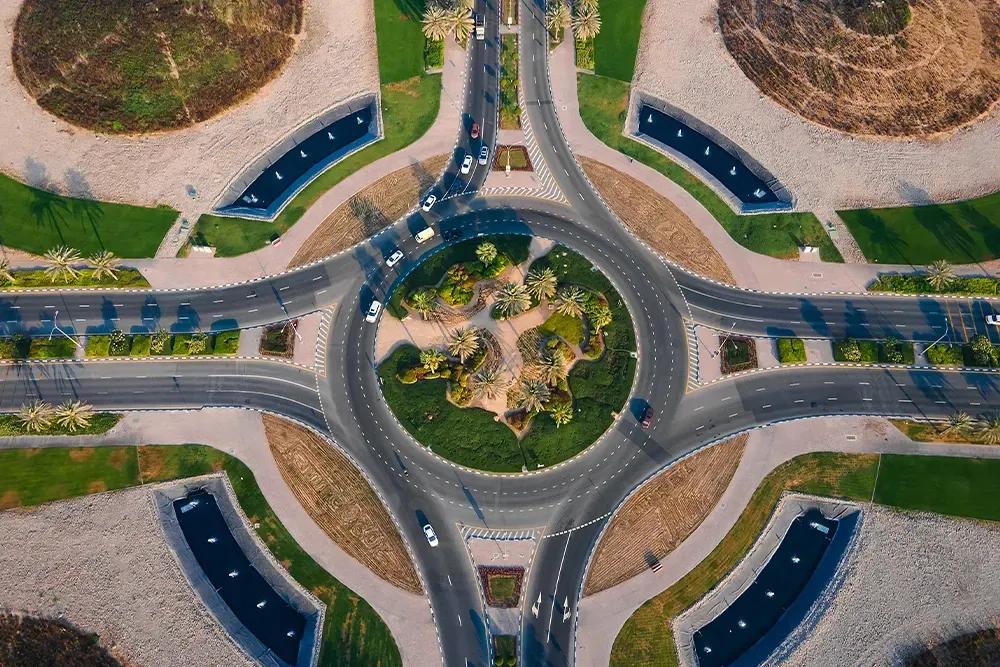Roundabout Rules in the UAE: A Complete Guide to 2, 3 & 4 Lane Circles

Key takeaways
- What Are the General Roundabout Rules in the UAE?
- How to Navigate a 2-Lane Roundabout in the UAE (Step-by-Step)
- How to Navigate a 3-Lane Roundabout in the UAE (Step-by-Step)
- 4-Lane and Complex Roundabouts: Advanced Rules
- Using Turn Signals (Indicators) on UAE Roundabouts: A Simple Guide
- Roundabout Signs and Road Markings in the UAE: What to Look For
- FAQ
For new drivers in the UAE, navigating a busy, multi-lane roundabout can be intimidating. Even the best drivers are nervous about a 3 or 4-lane circle at peak hours. But we're here to say that it's totally achievable if you know how it works. If you have a reasonable idea of the rules, you can manage to get through the traffic circles, which are built for efficiency. In this article, we are going to talk about the official roundabout rules in UAE, including the general laws and step-by-step processes for 2, 3, and even 4-lane roundabouts.
What Are the General Roundabout Rules in the UAE?
To understand multi-lane roundabouts, it is vital we first become acquainted with the rules that apply to most roundabouts throughout the country. These basic rules safeguard people while ensuring efficient traffic flow.
Here are the main things to remember:
- Cars already in the roundabout have the right of way. This is the most critical rule.
- Enter only when it is safe to do so. Do not force your way into traffic.
- Drive in a counter-clockwise direction.
- Stay in your lane. Avoid unnecessary lane changes while on the circle.
- Always keep an eye out for pedestrians at crosswalks on exits.
A good driver will use these basic rules to deal with a roundabout.
Who Has Priority on a Roundabout? The Golden Rule
Vehicles already circulating in the roundabout always have priority, so you must always wait until there is a safe gap in the traffic coming from your left before entering the circle. Most of the time, you will see a “Yield” roundabout sign or markings on the road indicating you must give way.

Using Your Indicators: When to Signal on a Roundabout
To convey your intentions on the road, it is important to properly use your indicators. The rule is straightforward:
- You do not need to signal on entry to a roundabout, except when taking the first exit to the right.
- You must always use your right indicator just before you are about to take your desired exit. This tells drivers behind you and those waiting to join that you are leaving the roundabout.
How to Navigate a 2-Lane Roundabout in the UAE (Step-by-Step)

Two-lane roundabouts are very common. Mastering them is essential for everyday driving. The key is choosing the correct lane before you enter.
Lane Choice When Entering a 2-Lane Roundabout
Your choice of lane depends on which exit you plan to take. The general 2 lane roundabout rules are as follows:
- Use the right lane if you plan to go straight or take the right exit (1st and 2nd exits).
- Use the left lane if you want to go straight (2nd exit), take a left (3rd exit), or make a U-turn (4th exit).
The arrows on the road can always be verified to ensure you are in the right lane for your intended direction.
Exiting a 2-Lane Roundabout Safely and Correctly
How you exit is just as important as how you enter.
- Stick to your lane when traveling around the circle to avoid collisions.
- As you pass the exit before the one you wish to take, signal your intention by putting on your right indicator.
- Before making the turn to exit, check your right-side mirror and your blind spot for any vehicles.
- Leave the roundabout, entering the corresponding lane for your direction of travel.
Navigating two lane roundabout rules is easy with these clear guidelines.
How to Navigate a 3-Lane Roundabout in the UAE (Step-by-Step)

The 3 lane roundabout rules may seem complicated, but they’re not. The same logic applies as a 2-lane roundabout, with the exception that the extra lane allows for a specific movement. Getting the lane choice right from the start is critical.
Choosing the Correct Lane on a 3-Lane Circle
The roundabout rules 3 lanes UAE separate traffic logically. Use road markings and signs for guidance, but generally, the rule is as follows:
- Use the right lane to exit the roundabout by taking the 1st exit. Sometimes, signs may also permit going straight (2nd exit).
- The center lane is typically meant to take the 2nd exit (go straight).
- The left lane is meant for the third and fourth exits (left turn or U-turn).
The proper lane must be chosen well in advance to negotiate these big roundabouts smoothly.
How and When to Exit a 3-Lane Roundabout
Exiting a 3-lane roundabout requires extra awareness.
- Signal your intention in advance. Just like in a 2-lane roundabout, after passing the exit before yours, indicate right to take your desired exit.
- If you are in the middle or left lane and need to cross other lanes to exit, do this safely before your exit. Check your mirrors and blind spot, indicate, and ensure there is a safe gap before you turn into the lane on your right.
- You should ideally exit from the right-most lane of the roundabout.
- Use the directional arrows to exit into the proper lane for your continuing journey.
4-Lane and Complex Roundabouts: Advanced Rules

The 4 lane roundabout rules are much the same as those for 3-lane roundabouts, only they require more confidence. Before entering a multi lane roundabout, overhead signs and road markings will indicate which lane to use for your destination.
Due to high traffic flow, many complex roundabouts also have traffic lights on their entry points, meaning they can function as signalized intersections. Always be prepared to stop.
Using Turn Signals (Indicators) on UAE Roundabouts: A Simple Guide

To summarize, use your indicators as mentioned below.
When to Signal When Entering and Exiting
- Usually, you don’t need to give a signal when entering a roundabout, except if you’re taking the very first exit to the right. In that case, approach with your right indicator on.
- Always indicate right before you exit a roundabout. After you have gone past the exit before the one you intend to take, switch on your signal. This is one of the most important roundabout rules.
Roundabout Signs and Road Markings in the UAE: What to Look For

The UAE’s system of signs and markings assists road users with roundabout navigation.
- The main roundabout sign is a blue circular sign with three white arrows pointing counter-clockwise (sign 4.3). This warns you that you are approaching a roundabout.
- The Yield sign is a triangular sign, which reminds you that you must give way to all traffic that is already on the circle.
- As you get nearer, look for large white arrows painted on the road. These arrows indicate which way each lane is allowed to go – for example, right only, straight, or left/U-turn. Following these is crucial.
Paying attention to these road signs is key to navigating correctly and safely.
We have addressed a few of the frequently asked questions from our clients when it comes to driving on roundabouts in the UAE.
FAQ
Are roundabout rules the same in Dubai, Abu Dhabi, and Sharjah?
The main dubai roundabout rules, like giving priority to cars already on the roundabout and indicating your exit, apply in all emirates, including the roundabout rules Abu Dhabi. However, complicated roundabouts may have different signage and lane markings, so always follow the signs.
What is the most common mistake on roundabouts?
The most common mistake is not choosing the right lane before entering the roundabout. This usually leads to dangerous, last-minute lane changes on the circle. Another mistake is not using the right indicator when exiting.
Who is at fault in a roundabout accident?
Usually, when an accident occurs between a car that is already on the circle and a car entering, the one entering is at fault because they must yield priority. If a crash happens inside the roundabout, the driver who changed lanes unsafely is likely to be at fault.
Recent Articles
- Best Afternoon Tea in Dubai
- Quranic Park Dubai: A Visitor’s Guide to Faith and Nature
- Dubai Shopping Festival 2025-2026
- Top Luxury Rental Car Services in Dubai in 2025-26
- Top 10 Luxury Cars to Rent in Dubai 2025-26: Prices, Reviews & Booking
- Driving in Dubai: Your Ultimate Guide to Rules, Licenses & Safety
- UAE Driving License Guide: Using Foreign Licenses in UAE & Abroad
